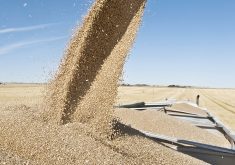The prairie oat crop could swing toward either a good crop that will leave few supply problems, or to a string of problems that will leave the market short.
If there is sustained heat over the next few weeks the milling oat crop will be about average, says Randy Strychar of Ag Commodity Research. But if the hot days don’t come, significant parts of the crop will be in jeopardy.
“The biggest concern right now is frost coming in the fall,” said Strychar, an oat market analyst.
Read Also

Soybean market still figuring out implications of China-U.S. pact
Soybean futures had a muted reaction to the U.S. trade deal with China as the market tries to figure out the nuances of the deal.
Oat development varies widely across the Prairies, with many farmers getting their crops seeded on time and in good conditions this spring, but others delayed for weeks by rain, snow and cold weather.
Larry Vendsel, manager of marketing for Emerson Milling in Emerson, Man., said farmers in his area were fortunate.
“In this area everything was put in before the snow,” said Vendsel.
“The crop’s looking very good right now. Everything’s nice and lush and green.”
But many pockets of the Red River Valley were too wet for seeding before mid-May, when a giant snowstorm hit and delayed seeding further.
Continued heavy rains kept the valley’s clay soils saturated and many crops weren’t seeded until mid-June.
The crops developing now have good growing conditions, but the high humidity may bring disease problems. It’s unclear whether fusarium and other fungal diseases are attacking the crop, Strychar said.
“Right now we’re looking at the potential for problems, as opposed to real problems in the field … so the market has completely ignored what’s going on,” said Strychar.
Manitoba Agriculture thinks some eastern Manitoba oat crops may be cut as greenfeed if they develop too slowly.
Strychar said feed oats will not be hard to find this fall because the oat acreage is not low. U.S. buyers will be able to get oats even if Manitoba crops fall short, but they’ll have to get them from western Manitoba and eastern Saskatchewan, which can add 15-20 cents per bushel in transportation costs.
He thinks oat futures at the Chicago Board of Trade should rise to reflect that possible increase in transportation cost. He said oat prices could easily move higher if production problems begin to be noticed.
“Until we get real crop damage, oats will continue to track corn,” said Strychar.
Agriculture Canada’s July 5 estimate puts oats production at 3.63 million tonnes, down slightly from 3.69 million last year.
Farmers should be cautious in selling new-crop oats while there is potential for oats to break free of corn, Strychar said.
“It’s not a bull market by any means, but growers should be cautious before selling anything else.”
If the weather is perfect for the rest of the summer, an adequate oat crop will be produced, but that isn’t a safe bet.
“Unless we get a tremendous amount of heat and some rapid development, we could have problems,” said Strychar.
“If we had a great crop with terrific quality, that’d be enough (for buyers’ needs), but we’re not seeing that right now.”















